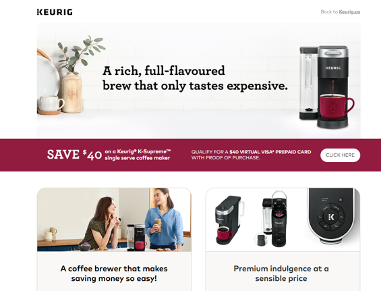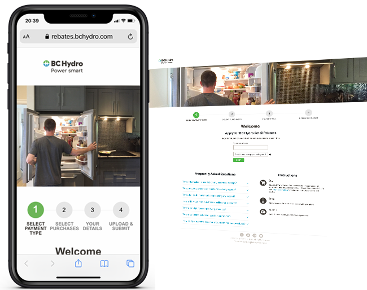A digital rebate is a cash-back discount or incentive a brand or manufacturer offers to consumers to encourage them to buy a product.
Unlike a price discount at the point of sale, a rebate is a reward you get after you purchase a product. However, some conditions may apply before you can get the reward.
53% of Americans participate in more than US$76 billion in rebates or money-back offers.
The Old Way to Offer Rebates
Traditionally, rebates were mailed in before a consumer could get their reward. The consumer would purchase a product and get a rebate card to send to the manufacturer or brand. The consumer would then fill in the card with their information and mail it along with the purchase receipt or a UPC to prove they did buy the product.
Mail-in rebates had challenges, including people copying receipts or UPCs and sending in duplicates with fake contact info.
While paper rebates still exist, they are not great for building loyalty or customer experience. Consumers don't want to take the time to complete the form and mail in everything required, and they don't want to wait weeks or months to get their reward.
From Paper to Digital Rebates
Digital rebates encourage consumers to try new products or switch brands. They can also get consumers to go to a store they don't frequent or purchase a product they wouldn't typically buy because it's too expensive.
With a digital rebate, consumers can get their reward faster. The consumer can take a picture of their receipt and upload it with their personal information to a rebate portal or website or via a mobile app. Once the validation process is complete, they will get an email or an SMS with a digital code they can redeem. Rebates can also be in the form of money in their mobile wallet, a store gift card, cash-to-card, paper cheque, Paypal transfer, digital code to redeem at a store, and more.
Research from Snipp shows that 70% of consumers are more likely to take advantage of a rebate if they can submit it online or using their mobile device.
Digital Rebates Benefits
There are many benefits of digital rebates, not just for the consumer but also for the brand or manufacturer. For the consumer, the immediate benefit is the reward they receive. But also, by providing their information to brands, they benefit from additional promotions and personalized offers and experiences.
Brands and manufacturers typically have no direct contact with the consumers that buy their products. Unfortunately, this lack of contact means they don't have access to the rich customer data that can help them market their products better or improve marketing messaging and advertising.
Digital rebates can help with the data challenge:
- Capture Rich Customer Data: Rebates provide brands with a treasure trove of customer data. From where products are purchased to retailer preferences, demographics, and other purchase information, this data helps brands understand their market better and enables them to improve their product and marketing strategies.
- Create Brand loyalty: Consumers buy from brands that make it easy to do business with them. And they are always looking for deals. Brands that do these things garner loyalty; in some cases, customers will even advocate for them.
- Improve Marketing: Rebates are a great way to create buzz around a new product trying to gain market share or as a way to sell the final stock of a product due for retirement.
- Increase sales/market share: For brands trying to increase a product's sales or market share, rebates can encourage consumers to switch to their product over the competition.
Digital rebates also provide a level of fraud prevention to rebates programs traditional approaches don't have. Unique serial numbers, sell-in, and sell-out data, tracking against actual inventory, and capturing digital footprints (IP address, smartphone identifier), all help brands ensure that rebates are submitted and completed securely and properly.
Rebate software is needed to provide these security and fraud measures and help brands and manufacturers track and monitor rebates across brands, products, time spans, and geographies.
A Note Manufacturer Rebates
Manufacturer rebates work for both suppliers and the end consumer. When offering rebates to suppliers or distributors, the intent is to incentivize distributors to buy their products. Rebate types include discounts on new products when purchasing other products, rebates on the incremental growth of purchases over a period, end-of-life product promotions, and others. In all cases, manufacture rebates to distributors are given after the products are purchased once the conditions are met.
Examples of Digital Rebates
Keurig Dr Pepper
Keurig Dr Pepper implemented a digital rebate program on their website where consumers who purchased any qualifying K-Supreme product could upload a photo of their receipt and register to get a $40 Rebate.

PURELL
PURELL implemented a rebate program to drive trials of a new product. Consumers who purchased six products could submit their receipts by texting "PURELL" to 811-811, via email, or through a web upload at https://www.PURELLOffers.com to receive a $5 rebate in the form of a virtual visa gift card.
BC Hydro
BC Hydro updated its Retail EE Rebate program to become more streamlined, offer customers choice in the method of receiving their rebate, and reduce the effort at POS to execute. Customers uploaded a photo of their receipt via email and received up to $100 in cashback per product purchased across several categories, including appliances, bathroom fans, and programmable thermostats. The program included hundreds of product SKUs available at several retail locations throughout the province. Customers chose the rebate type to receive, including Digital Visa Prepaid Card, Credit on Bill, or Interac e-Transfer.

Click here to earn how digital rebate management solutions can help a rebate program.

